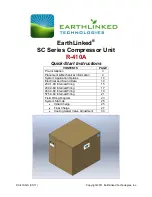
6 0 H Z
PRESSURE
S W I T C H
A L T E R N A T O R
I
S W I T C H
I
f - - - - - - - _ - i -
PRESSURE
S W I T C H
S T A R T E R
SET PS-2 AND PS-3 TO
SE
Q
UEN
C
E
,
5-10
(35-70
BELOW CUT-IN PRESSURE POINT OF
Fig.
Automatic Alternation with Backup and 11
Isolated Control of Three-Phase Motors.
OPERATIONAL CHECK
It is sufficient to confirm that both compressor pumps
have an off cycle and are not running continuously.
Switch over the manual alternation system or bleed air
from tank on automatic alternation system to confirm
startup and off cycle of both pumps.
Measure the cut-in pressure, pump-up time, cut-out
pressure, and off time under normal operating conditions.
Pump-up time should be below 50 percent operation
(less on time than off time) and operate between 70 to
90
(480 to 620
pressure. Check operation of
each
pump using manual switch over if necessary.
Record
these
figures for reference (a card attached to
the unit is handy). Decreasing off periods
(with
no change
in pressure range) indicate an increase in air consumption
with an increasing pump-up time. This could be due to
75-7268
6
added devices or leaks. Increasing pump-up time with no
change in pressure range
or
off time indicates wear in the
compressor pump and may warrant closer observation as
it is usually followed by
an
increase in oil consumption.
Check backup operation by operating the safety relief
valve (see SAFETY RELIEF VALVE paragraph).
The
second pump should cut in after the tank pressure has
dropped 5 to 10
(35 to 70
below cut-in
pressure for the first unit.
If
wear is suspected, check the dead-ended pump-up
time (pumping up tank with the system off) against the
value given in Table 3. If this time differs from the table
by more than 10 percent, troubleshoot according to
instructions given under WON’T PUMP AIR paragraph,
and take proper action.






































